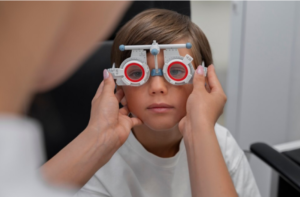Effective Strabismus Eye Treatment in Raipur, Chhattisgarh
Strabismus, commonly known as “crossed eyes,” is a condition where the eyes do not properly align with each other when looking at an object. This misalignment can be constant or intermittent and can affect one or both eyes. It is essential to address strabismus early to avoid long-term vision problems. Fortunately, residents of Raipur, Chhattisgarh, have access to excellent strabismus eye treatment options.

Understanding Strabismus
Strabismus can be categorized based on the direction of misalignment:
- Esotropia: One or both eyes turn inward.
- Exotropia: One or both eyes turn outward.
- Hypertropia: One eye turns upward.
- Hypotropia: One eye turns downward.
Strabismus can result from various factors, including muscle imbalance, neurological issues, or genetic factors. It can occur in both children and adults, but early diagnosis and treatment are crucial for preventing complications such as amblyopia (lazy eye) or permanent vision impairment.
Symptoms of Strabismus
Recognizing the symptoms of strabismus is the first step toward seeking treatment. Common signs include:
- Eyes that appear misaligned.
- Squinting or closing one eye in bright sunlight.
- Frequent eye rubbing.
- Head tilting to one side.
- Double vision (in adults).
Treatment Options for Strabismus in Raipur, Chhattisgarh
Raipur offers a range of treatment options for strabismus, ensuring that patients receive the best possible care designed to their specific needs. The treatment approach may vary depending on the severity and cause of the condition.
- Eyeglasses or Contact Lenses
For some individuals, especially those with refractive errors, wearing eyeglasses or contact lenses can help correct the misalignment. These corrective lenses aid in improving focus and alignment, particularly in cases where strabismus is caused by farsightedness.
- Prism Lenses
Prism lenses can be incorporated into eyeglasses to help reduce the amount of eye turn needed to look at objects. They work by bending light before it enters the eye, thereby reducing the effort required to maintain proper alignment.
- Vision Therapy
Vision therapy is a non-surgical method that uses a series of exercises to improve eye coordination and focus. These exercises are supervised by an eye doctor and can be very effective, especially for children. The therapy aims to strengthen the eye muscles and improve the brain’s ability to control eye alignment.
- Botulinum Toxin Injections
Botulinum toxin (Botox) injections can be used to temporarily weaken an overactive eye muscle. This can help improve alignment and may be a helpful option for certain types of strabismus. The effects are temporary, and repeated treatments may be necessary.
- Surgical Treatment
For more severe cases of strabismus or when other treatments have not worked, the doctor may recommend surgery. During the surgery, the eye muscles are adjusted to improve alignment. Strabismus surgery is usually done as an outpatient procedure, and patients can usually go home the same day.
Leading Eye Care Center in Raipur
Shree Retina Care
About: Shree Retina Care is a leading eye hospital in Raipur known for its comprehensive eye care services, including strabismus treatment. They have a team of experienced ophthalmologists and state-of-the-art technology.
Services: Strabismus diagnosis and treatment, LASIK surgery, cataract surgery, retinal treatments.
Why Choose Shree Retina Care: They offer personalized care and ensure a high success rate for strabismus treatments.
What to Expect from Strabismus Treatment
If you or your child is undergoing treatment for strabismus in Raipur, it’s important to understand the process and what to expect:
- Initial Consultation: The first step is a comprehensive eye examination to assess the degree of misalignment and determine the best treatment approach.
- Treatment Plan: Based on the examination results, the ophthalmologist will recommend a personalized treatment plan, which may include eyeglasses, vision therapy, or surgery.
- Follow-Up Visits: Regular follow-up visits are essential to monitor progress and make any necessary adjustments to the treatment plan.
- Recovery and Results: Recovery times vary depending on the treatment method. Vision therapy and non-surgical treatments may require several weeks to months, while surgical recovery typically takes a few days to weeks.
Conclusion
Strabismus can significantly impact quality of life, but effective treatment options are available in Raipur, Chhattisgarh. By choosing a reputable eye care center and following a designed treatment plan, patients can achieve better eye alignment and improved vision. If you or a loved one is experiencing symptoms of strabismus, don’t hesitate to seek professional help and take the first step towards a clearer, healthier vision.
